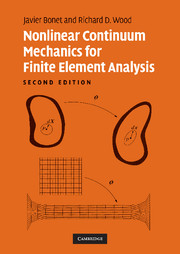Book contents
- Frontmatter
- Contents
- Preface
- 1 INTRODUCTION
- 2 MATHEMATICAL PRELIMINARIES
- 3 ANALYSIS OF THREE-DIMENSIONAL TRUSS STRUCTURES
- 4 KINEMATICS
- 5 STRESS AND EQUILIBRIUM
- 6 HYPERELASTICITY
- 7 LARGE ELASTO-PLASTIC DEFORMATIONS
- 8 LINEARIZED EQUILIBRIUM EQUATIONS
- 9 DISCRETIZATION AND SOLUTION
- 10 COMPUTER IMPLEMENTATION
- Bibliography
- Index
2 - MATHEMATICAL PRELIMINARIES
Published online by Cambridge University Press: 06 July 2010
- Frontmatter
- Contents
- Preface
- 1 INTRODUCTION
- 2 MATHEMATICAL PRELIMINARIES
- 3 ANALYSIS OF THREE-DIMENSIONAL TRUSS STRUCTURES
- 4 KINEMATICS
- 5 STRESS AND EQUILIBRIUM
- 6 HYPERELASTICITY
- 7 LARGE ELASTO-PLASTIC DEFORMATIONS
- 8 LINEARIZED EQUILIBRIUM EQUATIONS
- 9 DISCRETIZATION AND SOLUTION
- 10 COMPUTER IMPLEMENTATION
- Bibliography
- Index
Summary
INTRODUCTION
In order to make this book sufficiently self-contained, it is necessary to include this chapter dealing with the mathematical tools that are needed to achieve a complete understanding of the topics discussed in the remaining chapters. Vector and tensor algebra is discussed, as is the important concept of the general directional derivative associated with the linearization of various nonlinear quantities that will appear throughout the book.
Readers, especially with engineering backgrounds, are often tempted to skip these mathematical preliminaries and move on directly to the main text. This temptation need not be resisted, as most readers will be able to follow most of the concepts presented even when they are unable to understand the details of the accompanying mathematical derivations. It is only when one needs to understand such derivations that this chapter may need to be consulted in detail. In this way, this chapter should, perhaps, be approached like an instruction manual, only to be referred to when absolutely necessary. The subjects have been presented without the excessive rigors of mathematical language and with a number of examples that should make the text more bearable.
VECTOR AND TENSOR ALGEBRA
Most quantities used in nonlinear continuum mechanics can only be described in terms of vectors or tensors. The purpose of this section, however, is not so much to give a rigorous mathematical description of tensor algebra, which can be found elsewhere, but to introduce some basic concepts and notation that will be used throughout the book.
- Type
- Chapter
- Information
- Publisher: Cambridge University PressPrint publication year: 2008

